
Background to the French Nuclear Power Industry
In 1974, the French government decided to go ‘nuclear’ as the result of the oil shock and a lack of any real indigenous energy resources, this was known as the Messmer Plan after the then Prime Minister, Pierre Messmer. With nuclear power at the heart of energy strategy, the aim was to make France completely independent of the oil-rich nations. It was initially envisaged that 80 plants were to be built by 1985 with a further 110 plants in operation by 2000, based on electricity demand estimates doubling every 10 years.
Their demand forecasts fortunately did not come to fruition, and so actually there are currently only 58 commercially operated nuclear reactors in France (and one test fast breeder reactor) all operated by EDF, producing approximately 421TWh of electricity every year. These 58 reactors are situated within 20 nuclear power plants and accounted for 78% of the total electricity generated in France during 2011.
One of the major benefits of making the nuclear plants in relatively quick succession was that they were built to similar specification, which resulted in economies of scale during the manufacturing process, in addition to high levels of reliance. The plants are all pressurised water reactors, of which 34 are 3-loop reactors rated at 900MW, 20 are 4-loop P4 reactors rated at 1300MW and the final 4 are 4-loop N4 reactors with a capacity of 1450MW. Despite some of these plants being relatively old (in some cases over 40 years), they have all recently had the operating lifetimes extended through 2020.
In 2006, EDF confirmed it was going to be building another reactor within the Flamanville Nuclear Plant, Normandy. This will be rated at 1650MW, making it the largest reactor in France, and will give the Flamanville nuclear plant a total operating capacity of 4250MW (there are already 2 1300MW reactors in this location). As a result of the Fukushima atomic disaster, the start has been delayed and costs have also increased. It is thought the plant will now come on line in 2016, and will cost approximately £5bn to produce.
Matching Electricity Supply and Demand in France
As discussed elsewhere on TheGreenAge, nuclear power is a very inflexible source of electricity, with plants taking several days to generate electricity from their ’off-line’ mode. As such, nuclear power tends to provide much of the base power to the energy mix, with plants being kept on 24/7 as this is by far the most economical way of running the plants, and there is very little flexibility in their output (when compared to Hydroelectric Power or Gas Power). In France however, they have tried to use nuclear plants in a more flexible way, by attempting to match supply with demand, meaning some plants are not in operation over weekends. This has actually meant that the plants have a relatively low capacity factor (operating capacity as a percentage of full output capacity).
Despite this, matching supply and demand is not easy, and as such France exports much of the electricity it produces from nuclear, and imports electricity to help meet demand when it is especially high. Unfortunately it can only export electricity when demand is low, so the price that France receives for its exported electricity is also low. Conversely, when it suffers peaked demand and needs to import additional electricity it is obviously charged at a higher rate.
This was compounded in the years following the installation of the nuclear power plants, as there was substantial over capacity at this time, because the French government had over-forecast actual electricity demand. As a result, the government pushed the French population to use more electricity to try and increase the base load. The increased base load came from using electricity for heating as opposed to heating gas or oil. Unfortunately using electricity for heating is relatively inefficient, unless insulation is prevalent.
This over reliance on electricity for heating has resulted in sharp increases in electricity demand when the temperature drops, so actually the demand for imported electricity has increased and costs more.
Exporting French Produced Electricity to the UK
As mentioned above, to help regulate supply and demand better, EDF exports some of the electricity it produces in its nuclear power plants to neighbouring countries. In 2010, France exported 2.66TWh of electricity directly to the UK (National Grid), but in total it tends to export between 65-80 TWh / year to it’s neighbours.
Nuclear Energy – Electricity Prices and Environmental Costs
In 2009, EDF estimated that it produced nuclear energy at a cost of EUR 4.6 cents/kWh, while the energy regulator CRE put the figure at 4.1 cents/kWh, which is a relatively cheap source of power, however it does obviously produce nuclear waste that needs to be treated / stored, and there are decommissioning costs associated with nuclear power.
Nuclear waste is limited in France though compared to such countries as the USA, because it is allowed to reprocess old fuel rods, extracting the unused Uranium and Plutonium and making them into new fuel rods. The spent nuclear fuel is all reprocessed at the La Hague site (this site has almost 50% of the world’s reprocessing capacity), which over the years has faced some opposition from organisations such as Greenpeace.












this is a boomer source